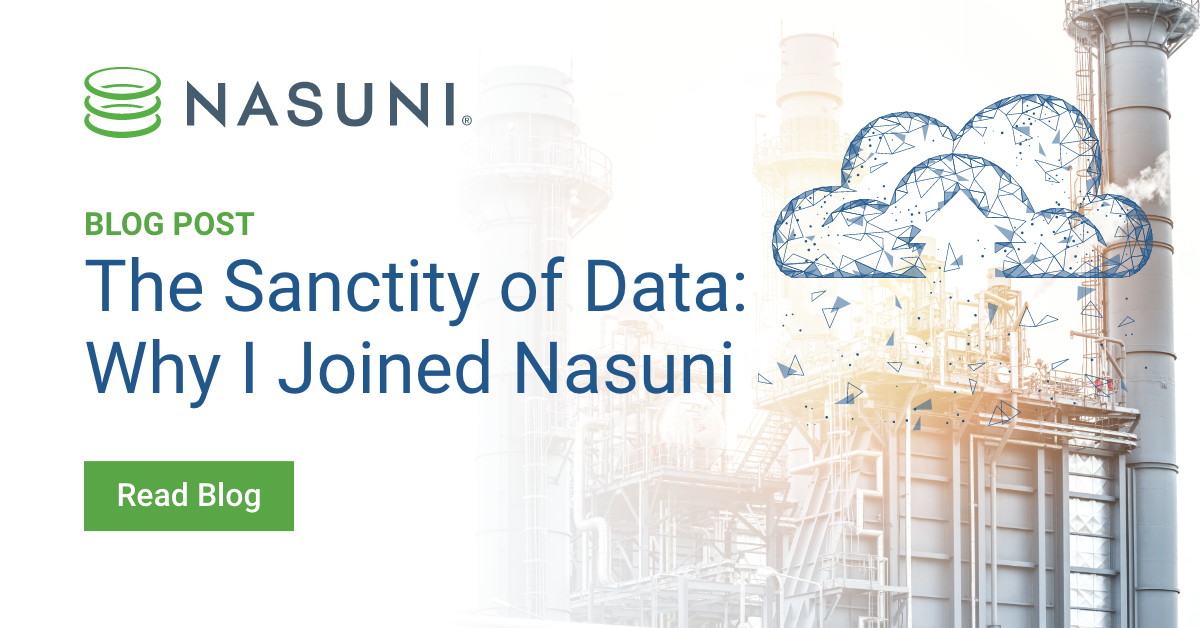The Sanctity of Data: Why I Joined Nasuni
If the energy industry teaches IT professionals one thing, it’s the importance of respecting the sanctity of data. Whether you devote internal resources to acquire seismic data or purchase it from another organization, this data is gold. Highly paid geoscientists and engineers need to be able to analyze it quickly and securely, wherever they might be in the world. If this data is lost, corrupted, or incomplete, these professionals can’t do their jobs, and the company loses money.
May 24, 2022

If the energy industry teaches IT professionals one thing, it’s the importance of respecting the sanctity of data. Whether you devote internal resources to acquire seismic data or purchase it from another organization, this data is gold. Highly paid geoscientists and engineers need to be able to analyze it quickly and securely, wherever they might be in the world. If this data is lost, corrupted, or incomplete, these professionals can’t do their jobs, and the company loses money.
Recently, I left my career as an energy industry IT specialist and joined Nasuni. The main reason: I’d finally found a solution that respected the sanctity of data. I’d deployed Nasuni at my previous company and witnessed the benefits firsthand. Eventually, I grew attracted to the idea of helping other Energy companies tap into the same capabilities.
Growing Datasets and Recovery Risks
When I joined my previous company in 2017, I inherited a small offsite data center, NAS drives scattered in different locations, tapes, and all of it loosely tied together via symbolic links. We lost a disk array the second week I was there, when I was still mapping the landscape, and I learned that not everything was being backed up properly, either. The firm’s leadership gave me two months to devise a new, forward-looking strategy for IT infrastructure.
Improving data protection was a primary concern, given the data loss event, so I started looking at standard, well-known Disaster Recovery and backup solutions. As I began to get a better sense of the needs of the organization, though, and the way data was being stored and shared between locations, I realized we needed a much broader upgrade.
We needed to improve file storage, data protection, and recovery times. I wanted to be able to leverage the cloud to expand capacity on-demand, since our datasets were growing exponentially. I wanted to make it easier for remote sites to access files. Facilitating the sharing of data between locations was going to be critical as well.
5 Priorities for Data Management in Oil & Gas
Eventually I revised and distilled my wish list into five priorities that I believe all Oil & Gas organizations should keep in mind:
- Be ready to support changing business growth initiatives.
- Implement the shortest possible path to final storage from ALL locations, no matter how extreme or remote.
- Shift to a cloud-first data storage strategy so you can manage scale in a flexible, cost-effective way.
- Create a golden master of all data from day 1 using immutable objects.
- Protect, Detect, Recover – deploy a fast, robust protection and recovery strategy at all levels of the stack.
Once I’d shaped my priorities, I decided I wanted something that could do the whole job in one go. Given the advances in cloud, I was convinced this sort of solution had to exist, and when I heard a conference presenter talking about his company’s solution, which was built around a file system that managed immutable versions in the cloud, I had my “aha” moment. I’d finally found my all-in-one solution!
After we transitioned to Nasuni, people weren’t sending data via email anymore. The data was accessible from anywhere, including offshore installations, and thanks to global file locking we didn’t need to worry about conflicts. We’d upgraded our protection, recoverability, and access without sacrificing performance. The technology also adapted to our needs when we shifted our corporate strategy from small to large acquisitions, satisfying the first priority on my list.
I’ll be writing more about these topics in the coming months, including a white paper that will detail the particulars of these five priorities, and why I think every IT leader in the Energy industry should be thinking hard about them.
Returning to the subject of why I joined Nasuni, I’d like to share one more reason — the people. When I was evaluating the product, and in the years following our initial deployment, everyone I interacted with at Nasuni was engaged and knowledgeable, with a deep understanding of the technology. Nasuni has built a great team, and I’m excited to be part of that group, and help shape the future of file data management in the Energy industry.